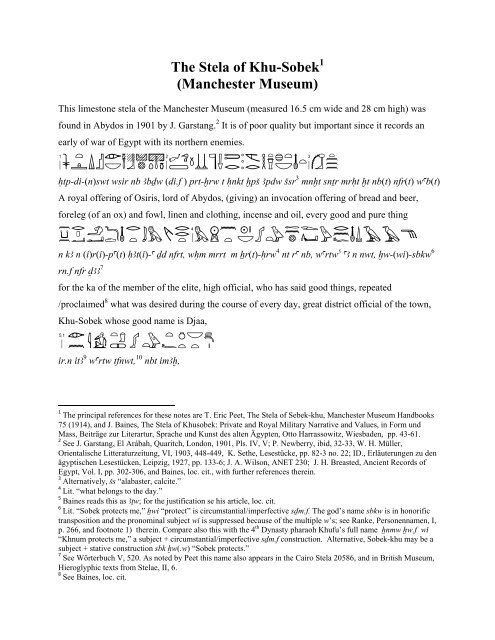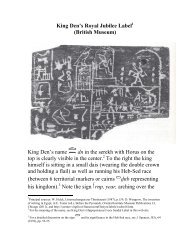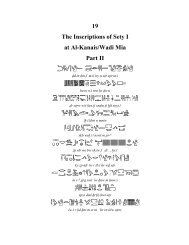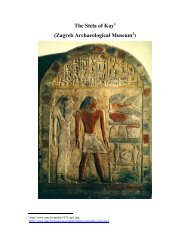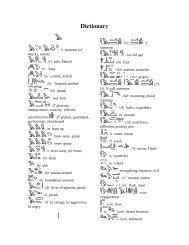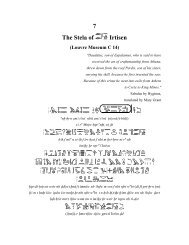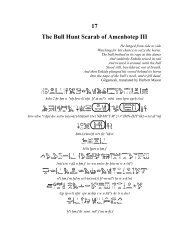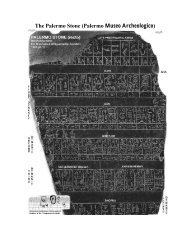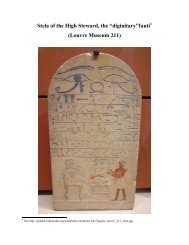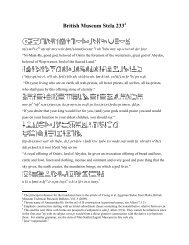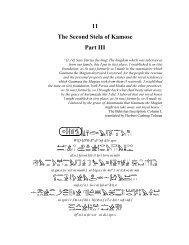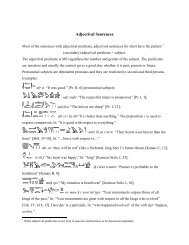The Stela of Khu-Sobek (Manchester Museum)
The Stela of Khu-Sobek (Manchester Museum)
The Stela of Khu-Sobek (Manchester Museum)
Create successful ePaper yourself
Turn your PDF publications into a flip-book with our unique Google optimized e-Paper software.
<strong>The</strong> <strong>Stela</strong> <strong>of</strong> <strong>Khu</strong>-<strong>Sobek</strong> 1<br />
(<strong>Manchester</strong> <strong>Museum</strong>)<br />
This limestone stela <strong>of</strong> the <strong>Manchester</strong> <strong>Museum</strong> (measured 16.5 cm wide and 28 cm high) was<br />
found in Abydos in 1901 by J. Garstang. 2 It is <strong>of</strong> poor quality but important since it records an<br />
early <strong>of</strong> war <strong>of</strong> Egypt with its northern enemies.<br />
Htp-di-(n)swt wsir nb AbDw (di.f ) prt-xrw t Hnkt xpS Apdw Ssr 3 mnxt snTr mrHt xt nb(t) nfr(t) wab(t)<br />
A royal <strong>of</strong>fering <strong>of</strong> Osiris, lord <strong>of</strong> Abydos, (giving) an invocation <strong>of</strong>fering <strong>of</strong> bread and beer,<br />
foreleg (<strong>of</strong> an ox) and fowl, linen and clothing, incense and oil, every good and pure thing<br />
n kA n (i)r(i)-pa(t) HAt(i)-a Dd nfrt, wHm mrrt m Xr(t)-Hrw 4 nt ra nb, wartw 5 aA n nwt, xw-(wi)-sbkw 6<br />
rn.f nfr DAA 7<br />
for the ka <strong>of</strong> the member <strong>of</strong> the elite, high <strong>of</strong>ficial, who has said good things, repeated<br />
/proclaimed 8 what was desired during the course <strong>of</strong> every day, great district <strong>of</strong>ficial <strong>of</strong> the town,<br />
<strong>Khu</strong>-<strong>Sobek</strong> whose good name is Djaa,<br />
ir.n itA 9 wartw tfnwt, 10 nbt imAx,<br />
1<br />
<strong>The</strong> principal references for these notes are T. Eric Peet, <strong>The</strong> <strong>Stela</strong> <strong>of</strong> Sebek-khu, <strong>Manchester</strong> <strong>Museum</strong> Handbooks<br />
75 (1914), and J. Baines, <strong>The</strong> <strong>Stela</strong> <strong>of</strong> <strong>Khu</strong>sobek: Private and Royal Military Narrative and Values, in Form und<br />
Mass, Beiträge zur Literartur, Sprache und Kunst des alten Ägypten, Otto Harrassowitz, Wiesbaden, pp. 43-61.<br />
2<br />
See J. Garstang, El Arábah, Quaritch, London, 1901, Pls. IV, V; P. Newberry, ibid, 32-33, W. H. Müller,<br />
Orientalische Litteraturzeitung, VI, 1903, 448-449, K. Sethe, Lesestücke, pp. 82-3 no. 22; ID., Erläuterungen zu den<br />
ägyptischen Lesestücken, Leipzig, 1927, pp. 133-6; J. A. Wilson, ANET 230; J. H. Breasted, Ancient Records <strong>of</strong><br />
Egypt, Vol. I, pp. 302-306, and Baines, loc. cit., with further references therein.<br />
3<br />
Alternatively, Ss “alabaster, calcite.”<br />
4<br />
Lit. “what belongs to the day.”<br />
5<br />
Baines reads this as ATw; for the justification se his article, loc. cit.<br />
6<br />
Lit. “<strong>Sobek</strong> protects me,” Xwi “protect” is circumstantial/imperfective sDm.f. <strong>The</strong> god’s name sbkw is in honorific<br />
transposition and the pronominal subject wi is suppressed because <strong>of</strong> the multiple w’s; see Ranke, Personennamen, I,<br />
p. 266, and footnote 1) therein. Compare also this with the 4 th Dynasty pharaoh <strong>Khu</strong>fu’s full name Xnmw xw.f wi<br />
“Khnum protects me,” a subject + circumstantial/imperfective sDm.f construction. Alternative, <strong>Sobek</strong>-khu may be a<br />
subject + stative construction sbk xw(.w) “<strong>Sobek</strong> protects.”<br />
7<br />
See Wörterbuch V, 520. As noted by Peet this name also appears in the Cairo <strong>Stela</strong> 20586, and in British <strong>Museum</strong>,<br />
Hieroglyphic texts from <strong>Stela</strong>e, II, 6.<br />
8 See Baines, loc. cit.
egotten <strong>of</strong> Ita (mother) <strong>of</strong> the district <strong>of</strong> Tefnut, possessor <strong>of</strong> honor.<br />
zAt.f mrt.f gbw 11 ir.n […], 12 sn.f ddw ir.n mrt-it(i).s, 13<br />
imi-r a-Xnwty xrw 14 ir.n xAsty, 15 mnat nt ib.f rn.f-anx 16 irt.n[ddi] 17<br />
iwbw irt.n mrt-it(i).s nbt-iwnt irt.n iwbw<br />
His daughter, his beloved, Sabu, begotten <strong>of</strong> ... His ‘brother,’ Dedu, begotten <strong>of</strong> Meret-iti-es.<br />
Overseer <strong>of</strong> the chamber, Kheru, begotten <strong>of</strong> Khaseti. <strong>The</strong> nurse <strong>of</strong> his heart, Renef-ankh,<br />
begotten <strong>of</strong> [Dedi]. Iubu, begotten <strong>of</strong> Meret-iti-es. Nebet-Iunet, begotten <strong>of</strong> Iubu.<br />
wDA 18 Hm.f m xd r sxrt mnTw-sTt, spr Hm.f r spAt skmm 19 rn.s<br />
His majesty proceeded downstream to overthrow the Bedouins <strong>of</strong> Asia. 20 His majesty arrived at<br />
the district named Sekmem.<br />
9 As noted by Peet, a rock inscription at Semna with precise date, the 9 th regnal year <strong>of</strong> Ni-Maat-Re (throne name <strong>of</strong><br />
Amenemhat III), also mentions <strong>Khu</strong>-<strong>Sobek</strong> as: .<br />
Here after the name itA the feminine mAat xrw “justified” proves that Ita is the name <strong>of</strong> a woman, therefore she is the<br />
mother <strong>of</strong> <strong>Khu</strong>-<strong>Sobek</strong>.<br />
10 Peet notes that ‘the words beneath the chair are a puzzle.’ On the other hand, pr tfnwt “<strong>The</strong><br />
House <strong>of</strong> Tefnut”(Wörterbuch V, 299) was a district (wartw) <strong>of</strong> iwnt Iunet, present-day Dendera. <strong>The</strong> connection<br />
with Iunet is also shown in the name <strong>of</strong> Iubu’s daughter (sixth seated figure), nbt-iwnt “mistress <strong>of</strong> Iunet.”<br />
11 Not zAbw Sabu,” see Ranke, PN I, 350.<br />
12 Probably not Meret-iti-es (see next) as the name has been intentionally erased (noted by Peet), and Meter-iti-es<br />
was the mother <strong>of</strong> two children, at least one from <strong>Khu</strong>-<strong>Sobek</strong>.<br />
13 Not Mert-itfes as mrt-iti.s means “beloved <strong>of</strong> her father.”<br />
14 Conjectural.<br />
15 Typical graphic transposition with the phonetic complement; see also line 6. Baines reads this as zmit.<br />
16 Lit. “his name is life.”<br />
17 Newberry’s reading.<br />
18 Narrative infinitive, see the Bull Hunt Scarab (line 6): nat Hm.f m xd.<br />
19 Usually identified with the biblical Shechem. In the spelling, the phonetic complement is in graphic transposition,<br />
see a variant writing (without transposition) in the next line.<br />
20 As noted by Breasted, this campaign belongs to the latter part <strong>of</strong> <strong>Khu</strong>-<strong>Sobek</strong>’s career. <strong>The</strong> anachronism here is<br />
due to <strong>Khu</strong>-<strong>Sobek</strong> attaching importance to this event. Based on context, grammar, and style, Baines actually places<br />
the horizontal lines 6-10 to the very end <strong>of</strong> the stela.
dit 21 Hm.f tp nfr m wDA n Xnw n anx(.w) (w)DA(.w) s(nb.w), aHa.n skmm xr.s 22 Hna rTnw Xzt<br />
(It was just when) his majesty was making a good beginning to return to the royal residence (lit.<br />
<strong>of</strong> lph), the Sekmem and the wretched Retjenu fell (descended?), 23<br />
iw.i Hr ir(t) 24 pH mSa, aHa.n Abx.n 25 anxw nw mSa r aHA Hna aAmw<br />
(while) I was serving (at) the rear <strong>of</strong> the army. <strong>The</strong>n the (foot) soldiers <strong>of</strong> the army engaged to<br />
fight with the Asiatics.<br />
aHa.n sx.n.i aAm, aHa.n rdi.n.i iT.tw xaw.f in anx 2 n mSa, nn tSt 26 Hr aHA<br />
<strong>The</strong>n, I struck the 27 Asiatic, and I had his weapons to be taken by two soldiers <strong>of</strong> the army 28<br />
without (me) stopping (lit. missing from) fighting,<br />
Hr.i Hz(.w), 29 n(i) rdi.i sA.i n 30 aAm<br />
I was brave, I did not turn my back on (lit. to) the Asiatic.<br />
anx n(.i) z(i)-(n)-wsrt, 31 Dd.n(.i) m mAat 32<br />
As Senwosret lives for me, I spoke in truth!<br />
/<br />
21 Narrative infinitive.<br />
22 Because <strong>of</strong> the introductory word aHa.n and the long topicalized subject (and the clauses that follow) one would<br />
expect here a circumstantial sDm.n.f/perfect instead <strong>of</strong> the rare indicative/perfective sDm.f (Gardiner (§480)).<br />
23 For the possible different interpretations, see the discussion in Baines, loc. cit.<br />
24 Typical unmarked adverb clause with pseudoverbal predicate. Note that iri can mean “serve” a god or a superior.<br />
25 For similar meaning, see Les. 83, 11.<br />
26 Negated infinitive. Baines cites a similar line from the biography <strong>of</strong> Amenemhab:<br />
, see Urk. IV, 892, 8-9.<br />
27<br />
<strong>The</strong> definite article is suggested by the context; it most probably refers to the chief, see Sethe, loc. cit., p. 134.<br />
28<br />
As Baines notes: “This means that he did not yield the temptation to plunder…”<br />
29<br />
Subject + stative construction, lit. “my sight is blessed,” an Egyptian idiom for “being brave;” see Wörterbuch, II,<br />
59. Baines translates this as: “my face looked forward,” i.e. “confronting.”<br />
30<br />
See GNS 34-5; negated indicative/perfective sDm.f<br />
31<br />
<strong>The</strong> goddess Wosret is in honorific transposition.<br />
32<br />
Typical emphatic construction using the nonattributive relative form <strong>of</strong> Dd and with the prepositional phrase m<br />
mAat emphasized; lit. “It is in truth that I spoke! See Allen (25.11.4). Note that the Semna stela has Dd.i while the<br />
nearly identical Uronarti stela has Dd.n.i.
aHa.n di.n.f n.i amaAt/zTz 33 m Dam r drt.i, mtpnt 34 Hna bAqsw bAk(.w) m Dam Hna xf a 35<br />
<strong>The</strong>n he gave me a throw-stick/staff <strong>of</strong> electrum, to my hand, a sheath and a dagger wrought (lit.<br />
worked) with electrum together with handle.<br />
(i)r(i)-pa(t), HAt(i)-a, mn Tbt, hr nmtt, 36 mDd-wAt nt smnx sw, 37 rdi.n nb tAwi f Aw.f, 38 sxnt mrwt.f<br />
st.f, wart aA n nwt, DAA<br />
Member <strong>of</strong> the elite, high <strong>of</strong>ficial, steadfast (lit. firm <strong>of</strong> sandal), easy <strong>of</strong> bearing, loyal (lit. one<br />
who adheres to the path) to (lit. <strong>of</strong>) the one who makes him advance, one to whom the lord <strong>of</strong> the<br />
Two Lands gave his splendor, one whose position his love promoted, the great district <strong>of</strong>ficial <strong>of</strong><br />
the town, Djaa.<br />
Dd.f ir.n.i n.i miHat tw sAx.ti, 39 smnx 40 st.s r rwD 41 nTr aA, nb anx, xnt (i) AbDw Hr wart nb(t) Htpt 42<br />
Hr nbt anx<br />
33<br />
Peet, following Newberry and Golenischeff, renders this as sTs “staff.”<br />
34<br />
According to Wörterbuch II, 170, this word is related to the obsolete tp “dagger” using the formative m.<br />
35 th<br />
<strong>The</strong>18 Dynasty pharaohs rewarded bravery by giving the weapons <strong>of</strong> the vanquished. Based on this Breasted<br />
conjectured the word in the lacuna to be xaww.f “his weapons.” As noted by Peet this does not fit into the outline<br />
and he believed that the missing word stands for a type <strong>of</strong> material complementing electrum. Baines gives the partial<br />
reading xfa and conjectures this as “handle,” related to the verb and noun xfa, “grasp.” <strong>The</strong> two signs at the end are<br />
probably birds.<br />
36<br />
See H. Polotsky, Zu den Inschriften der II. Dynastie, 3-8, and J. M. A. Janssen, De Traditioneele Egyptische<br />
Autobiografie vóór het Nieuwe Rijk, I, Z and I, Ak.<br />
37<br />
Janssen, loc.cit. II, Bc 10-25.<br />
38<br />
Compare this with the passage in the stela <strong>of</strong> Mentuhotep (UC14333) in this web site: rdi.n nb.f mrwt.f “one to<br />
whom his lord gave his love,” where the coreferent n.f is also suppressed.<br />
39<br />
Stative used as expression <strong>of</strong> state.<br />
40<br />
Passive participle.<br />
41<br />
According to Peet’s this passage refers to the terraced hillside surrounding the burial site at Abydos. Gardiner,<br />
however, interprets rwD as the staircase leading to the tomb (replacing the earlier shaft construction), and renders the<br />
phrase rwD nTr aA as the “tomb <strong>of</strong> Osiris.”<br />
42 Usually written with the plural strokes as .
He says: I have made for myself this tomb, beautified, its position ennobled (lit. one ennobled its<br />
position) at the staircase <strong>of</strong> the Great God/the tomb <strong>of</strong> Osiris, Lord <strong>of</strong> Life, Foremost <strong>of</strong> Abydos<br />
in the district “Mistress <strong>of</strong> Offerings” and in the district “Mistress <strong>of</strong> Life,”<br />
sn(.i) 43 snTr pr m xnt, H[tm.n.]tw(.i) 44 idt nTr, wartw aA, DAA<br />
(so that) I may smell the incense that came forth, (and) I may be provided with the divine<br />
censing, the great district <strong>of</strong>ficial, Djaa.<br />
Dd.f msy[.i] 45 rnpt 27 xr Hm.f (n)swt-bit(i) NBW-KAW-Ra 46 mAa xrw,<br />
xa 47 Hm.f (n)swt-bit(i) #a-KaW-Ra 48 mAa xrw m sxmti Hr st Hrw nt anxw,<br />
rdit 49 Hm.f ir.i 50 kAt m aHA m xt r gs Hm.f m z(i) 6 51 n Xnw<br />
He says: I was born in year 27 during the incarnation <strong>of</strong> the King <strong>of</strong> Upper and Lower Egypt.<br />
Nebkaura, justified. So, when his majesty <strong>of</strong> the King <strong>of</strong> Upper and Lower Egypt Khakaura,<br />
justified, wearing (lit. in) the double crown 52 mounted on the Horus throne <strong>of</strong> the living, his<br />
majesty made me adopt the pr<strong>of</strong>ession as a weapon trainer (lit. fighter <strong>of</strong> stick) beside his<br />
majesty along with six men <strong>of</strong> the Residence.<br />
aHa.n spd.n.i 53 r gs.f, rdit 54 Hm.f di.t(w) 55 (w)i r Smsw n HqA, rdi(w) 56 n.i tp 60<br />
43<br />
Sethe, loc. cit. p. 133.<br />
44<br />
Peet restores this as Htm.tw.i. Incense burning and smelling the incense, however, seem to be connected, and in an<br />
circumstantial clause <strong>of</strong> causality, the circumstantial sDm.n.f/perfect verb form is used. Alternatively, the scribe may<br />
omit the suffix n as it is present in the main clause.<br />
45<br />
It is unlikely that the verb msi has here transitive meaning “give birth, bear” as it has pronominal subject; see<br />
Allen (21.9). As Peet noted (JEA, Vol. 1, No. 3 (Jul., 1914), p. 210), the only other possibility is that msi has<br />
intransitive meaning “to be born” and as such it has the peculiar ending y.<br />
46<br />
Throne name <strong>of</strong> Amenemhat II.<br />
47<br />
A perfect relative form as it is the predicate <strong>of</strong> an emphasized adverb clause; see Allen (25.11.2).<br />
48<br />
Throne name <strong>of</strong> Senwosret III.<br />
49<br />
Narrative infinitive.<br />
50<br />
rdi + prospective/subjunctive sDm.f construction.<br />
51<br />
Not seven as in line 22. One stroke is for the seated man.<br />
52<br />
We follow here Sethe’s rendering. Baines interprets the two crowns as synonym for nswt-biti.<br />
53 spd is an adjective-verb “sharp, skilful, effective.”
I have become effective at his side, and his majesty caused that I be appointed to be a “Follower<br />
<strong>of</strong> the Ruler.” Sixty men have been given to me.<br />
wDA Hm.f m xntyt r sxrt iwntiw nw pDt, aHa.n sx.n.i nHsi [m knkf] 57 r gs nwtiw<br />
His majesty proceeded upstream to overthrow the desert Nubians (lit. tribesmen <strong>of</strong> the bow).<br />
<strong>The</strong>n I smote a Nubian [at Kenekef] in the presence <strong>of</strong> the/my townsmen.<br />
aHa.n.i xd.kw 58 Hr Sms m 6 n Xnw<br />
aHa.n rdi.n.f (wi) r sHD Smsw, rdi(w) n.i tp 100 m qfA<br />
<strong>The</strong>n I proceeded downstream in attendance (lit. following) with six men 59 <strong>of</strong> the Residence.<br />
<strong>The</strong>n he appointed me to “Inspector <strong>of</strong> the Followers.” One hundred men have been given to me<br />
as a reward.<br />
54 Narrative infinitive.<br />
55 Prospective/subjunctive sDm.f.<br />
56 Passive.<br />
57 Peet’s conjectural rendering. Baines notes that this geographical name is not attested but it is probably around the<br />
Second Cataract region.<br />
58 Subject-stative construction.<br />
59 Wilson’s rendering. Baines translates this passage as: “And then I went north, performing service, in a 6-ship <strong>of</strong><br />
the Resudence.” His “6-ship” is known from the Old Kingdom title “overseer <strong>of</strong> F6-ships;” and the so-called<br />
analogous “8-ships” are well attested, e. g. [Urk. IV, 1237, 1].


